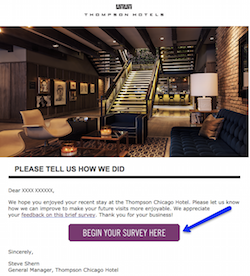11 marketing acronyms essential to growing your business
Here are ten acronyms that will help you market your business and sound and act like a business pro.

As you grow your business, you’ll find you’ll need to learn all sorts of strange business language, which more often than naught comes in the form of acronyms.
Stop drowning in acronyms and take the power back
Take Samantha, a hypothetical hotel owner who inherited a small family-run hotel from her grandparents and took over without any hotel or business experience.
When she met with colleagues, investors, or potential partners who threw around fancy terms she’d never heard, she had to pretend she knew what they were talking about.
The acronyms, in particular, made her feel like she was drowning in alphabet soup. She had a suspicion there was something she was missing and not doing right, especially with marketing.
Asking for clarification was embarrassing, but once she was faced with the threat of losing the family’s hotel, she had no choice.
Are you in the same boat? If so, you are not alone.
Here are 11 acronyms that will help you understand how to market your business and sound like a pro:
1. CTA – Call to Action
And that means. . . what?
You may not know it, but you’ve responded to CTA’s more times than you can count.
- That time you clicked on a button to download a sample of a book?
- That time you clicked on a link in an email to subscribe to a newsletter?
- That time you clicked on a pop-up window and donated to your favorite charity?
Yup. Those were all calls to action that were intriguing enough to get you to respond.
What is a call to action?
A call to action is a button (with or without an image) or line of text that prompts action, such as:
- Buy
- Sign-Up
- Book Now
- View Demo
- Subscribe
- Download [sample, .pdf, trial, etc.]
CTA’s are most often associated with websites, but they’re commonly used in marketing emails and social media campaigns. To learn how to fine tune your CTAs and drive up your online transactions we advise you to read our tips for making click-worthy calls to action.
For example
Think about the website for Samantha’s hotel. When the hotel first opened, the website was gorgeous and easy to navigate. The images of her hotel were so breathtaking they made even the most reluctant travelers want to get on a plane.
So, why weren’t visitors to her site making reservations? There could be many reasons. But the most obvious answer is that there was no CTA, like an attractive, impossible-to-miss, tempting button asking customers to “reserve now.”
This CTA from Villa Florence in San Francisco makes it easy to reserve a room directly from Facebook:

You need to know this term because:
Imagine that you’ve seen a fantastic offer from your cell phone provider, and you’re willing to spend more money every month to get more in return.
You go to their website, but you can’t figure out how to upgrade. How much time would you be willing to put into searching?
The last thing you want is for potential customers and clients to become frustrated while they’re trying to find what they’re looking for, or not be sure why they’re even visiting your site.
When you truly understand what you want your customers to do (sign-up for your webinar, order your product, watch a video, etc.), you’ll know how to make it easy for people to take advantage of what you have to offer.
2. CTR – Click Through Rate
And that means. . . what?
Voila. You have a bright and shiny new call to action right in the middle of your homepage. Great! Right? Well, probably. But to know how effective your CTA is, you need to know the CTR, or how many people are clicking on it. The same goes for ads.
For example
Samantha just paid a significant amount of money for an ad that’s prominently featured on the website of a local winery. Is the ad attention-grabbing? Is it worth the money? She’ll know the answers to these questions once she knows the CTR.
You need to know this term because
If your ad or call to action has a high CTR, you know to keep doing more of the same (with improvements and changes as necessary). If not, well, you know that something needs to change, and in the meantime, you can stop wasting time and money.
3. Conversion Rate
And that means. . . what?
Another measure of success is your conversion rate, meaning the number of clicks (see above) that result in a conversion (new customers, clients, or buyers).
For example
Samantha’s online reservation form might be getting more clicks than she expected, but the only way that will help her is if an appropriate percentage of those clicks results in an actual reservation.
What should that percentage be? In Samantha’s case, if she were measuring conversions directly from her website, she’d be in the typical range with a CR of 2-3%. Yes, that seems low, but it’s all relative.
You need to know this term because
You may be getting an unbelievable number of clicks on an ad or call to action, but are the right people clicking? If not, you might not be promoting your business in the places that will help you most.
Your conversion rate will help you figure out who your target audience is and how best to reach them. Increasing your conversion rate may take some trial and error, but you’ll get there.
4. BR – Bounce Rate
And that means. . . what?
A high CTR is great, and a high CR is even better. But what about the opposite side of that coin?
Your bounce rate will tell you how many people are coming to a specific webpage without clicking or taking any action and give you a hint as to the effectiveness of your CTA.
For example
Before Samantha redesigned her website, the bounce rate for her homepage was really high. She had a link to a virtual tour of her hotel, but most of her visitors didn’t click on it, and even fewer made reservations.
Once she started including CTA’s and understanding her site’s CTR, she refined her site. Her bounce rate decreased dramatically.
You need to know this term because
When you have a party, you don’t want guests to leave before they’ve even tried an appetizer. And you don’t want visitors to visit your site and leave before they’ve clicked on even one link.
5. KPIs – Key Performance Indicators
And that means. . .what?
At first, KPIs can seem complicated. But it’s not as complicated as some make it sound. A KPI is simply a measure of how well a particular strategy or method you’re implementing is working in your favor. Wait, are you wondering if a KPI is the same as your CTR? It could be. But in most cases, a KPI measures something more specific than clicks.
For example
Samantha has dedicated a percentage of her budget to advertising on social media. How well are her ads working? The number of times people click on her ad (or, the CTR), is a KPI. An even more accurate and useful measure of how well the ad is working would be the conversion rate.
Samantha also measures:
- The number of five-star reviews her hotel receives on TripAdvisor.
- The conversion rate of a blog post about the hotel and the area.
- How much profit does she earn from specific packages and special offers?
You need to know this term because
- You don’t want to waste time and money on strategies that aren’t helping you grow your business.
- You need to know what’s working and what’s not.
6. ROI – Return on Investment
And that means. . . what?
You’ve measured your CTR, CR, and BR, and implemented KPIs. What’s next? What about your money? That’s where ROI comes in. ROI is the ratio between what you spend and how much you get back in return. As in, if you spend $2.00 and make $7.00, your ROI is 250% (or $5.00).

For example
Email marketing has an ROI of 4,300%, meaning that if the cost of sending one email is $1.00, the return is about $43.00.
If Samantha spends money on new TVs for her rooms, will she be able to justify raising her rates enough to earn the money back? She’ll have to calculate the ROI to find out.
You need to know this term because
Understanding ROI prevents you from spending money and time on things that aren’t beneficial to your business. Use a free ROI calculator to get a better understanding of your earnings. But keep in mind that to know how well you’re really doing, you need to be aware of how much your competition is earning.
For example, if a hotel owner like Samantha charges $75.00 a night for a basic room, and the hotel down the block charges $125.00 for a similar room, you need to raise your rates, even your hotel is already making money.
7. B2C – Business to Consumer
And that means. . .what?
Your CTA’s are working, and you’re feeling pretty successful. You’re building an audience. What now?
You communicate. As soon as you can, as much as you can, however you can (all within reason, of course). “B2C” is communication, including marketing, between a business and prospective or existing customers.
You need to know this term because
Staying in contact with your customers, and understanding their needs and wants is an essential part of running a business. The more you know about your customers, the more you’ll have an upper hand when you’re figuring out your marketing strategies.
8. B2B – Business to Business
And that means. . .what?
Don’t forget, other businesses are potential customers, too. “B2B” is communication between two businesses, which can include marketing or any sort of partnership.
For example
Think of Samantha’s communication with the company that sells the linens she buys for the hotel, or her contract with the coffee company that rents a small space in the corner of her lobby.
She’s working on marketing her banquet space to event planners and caterers and selling blocks of rooms to companies for their retreats and conferences. These are all examples of B2B.
You need to know this term because
As a small business owner, you can’t exist in isolation. There’s no reason another business can’t be one of your customers, and there’s definitely no reason not to form partnerships. Two businesses are better than one!
9. CRM – Customer Relationship Management
And that means. . . what?
Now that you have so many business contacts and customers, you’ll need a way to keep track of them
A CRM helps you organize and keep track of all of your business relationships. A CRM for a new, very small business can be a spreadsheet with your professional contacts. But as businesses grow, they usually need a more sophisticated system.
You need to know this term because
A CRM offers so much more than just a list of customers. By having a well-organized, up-to-date CRM, you can learn about your target audience, reach out to prospective customers (leads), and figure out new marketing strategies.
Samantha would do well to meet with the owner of the local water park to work on joint marketing efforts that combine the data from both of their CRM systems and work together on their marketing efforts.
10. CMS – Content Management System
And that means. . .what?
Until now, we’ve been talking about creating content. But what hasn’t been talked about is the technical side of creating your content and how to organize it. A content management system keeps track of all the content you put on your website, from the moment a piece of content is uploaded or created to the moment it’s published and distributed.
For example
WordPress and Wix are two of the most popular content management systems. Both allow the creation and publication of content with navigation and organization built-in. WordPress plugins can even help with distribution on social media.
You need to know this term because
If you create every page of your website from scratch, you have to create your own organizational system.
No matter how much time you spend creating folders, it’s unlikely that you’ll be able to create a system as streamlined and quick as a tool like WordPress. As your business grows, so will your content, and you’ll want to save all the time you can.
11. SEO – Search Engine Optimization
And that means. . .what?
With all the time you spend creating content, you’ll want to be sure people find it. SEO is a group of strategies and techniques for bringing more visitors to your website. Using these strategies will improve the chance of your website appearing high on the list of search engine results.
For example
Samantha’s hotel is located near a famous beach that attracts a huge number of visitors each summer.
She’ll want to make sure that the name of the beach is one of her keywords so that people who google the beach see search results for her hotel. Just remember that as important as SEO is, engaging and meaningful content matters more than anything.
You need to know this term because
A website won’t do you much good if it comes on page two or three of a long list of search engine results. With SEO, you can make sure you literally and figuratively work your way to the top.
Takeaways
These acronyms shouldn’t be dismissed as jargon or fancy lingo. They represent marketing concepts that are crucial to the growth and success of any business.
Without understanding these terms and using the strategies they represent, our hotel owner Samantha would be treading water, or worse, sinking. But now the hotel is thriving and she’s speaking and marketing as a true pro.

